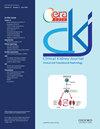近端肾小管肥大和功能亢进:疾病状态下的一种新的病理生理学特征
IF 4.6
2区 医学
Q1 UROLOGY & NEPHROLOGY
引用次数: 0
摘要
近端肾小管是位于肾皮质的肾小管结构的主要组成部分,它在健康和疾病状态下的作用已得到广泛研究。近端肾小管在重吸收各种分子(包括电解质、氨基酸和单糖)、跨细胞转运不同激素和调节体内平衡方面发挥着生理作用,此外,影响近端肾小管的病理事件可能是多种疾病的根源。尽管近端肾小管肥大或功能亢进起初是对各种刺激或肾小管转运蛋白改变的一种代偿机制,但已被证明是导致糖尿病、肥胖症、代谢综合征、充血性心力衰竭等多种疾病的关键病理生理事件。此外,药物治疗剂主要针对近端肾小管,包括钠-葡萄糖共转运体-2、尿酸盐转运体和碳酸酐酶。在这篇叙述性综述中,我们将重点介绍近端肾小管在健康状态下的生理作用,以及目前对导致疾病状态的近端肾小管病变和潜在治疗靶点的认识。本文章由计算机程序翻译,如有差异,请以英文原文为准。
Proximal Tubule Hypertrophy and Hyperfunction: A Novel Pathophysiological Feature in Disease States
The role of proximal tubules, a major component of the renal tubular structure located at the renal cortex, in healthy and diseased states has been examined extensively. Along with its physiological role in the reabsorption of various molecules, including electrolytes, amino acids and monosaccharides, transcellular transport of different hormones and regulation of homeostasis, pathological events affecting proximal tubules may underlie multiple disease states. Proximal tubular hypertrophy or hyper-functioning state, despite being a compensatory mechanism at first in response to various stimuli or alterations at tubular transport proteins, have shown to be critical pathophysiological events leading to multiple disorders, including diabetes mellitus, obesity, metabolic syndrome, congestive heart failure. Moreover, pharmacotherapeutic agents have primarily targeted proximal tubules, including sodium-glucose cotransporter-2, urate transporters and carbonic anhydrase enzyme. In this narrative review, we focus on the physiological role of proximal tubules in healthy states and the current understanding of the proximal tubular pathologies leading to disease states and potential therapeutic targets.
求助全文
通过发布文献求助,成功后即可免费获取论文全文。
去求助
来源期刊

Clinical Kidney Journal
Medicine-Transplantation
CiteScore
6.70
自引率
10.90%
发文量
242
审稿时长
8 weeks
期刊介绍:
About the Journal
Clinical Kidney Journal: Clinical and Translational Nephrology (ckj), an official journal of the ERA-EDTA (European Renal Association-European Dialysis and Transplant Association), is a fully open access, online only journal publishing bimonthly. The journal is an essential educational and training resource integrating clinical, translational and educational research into clinical practice. ckj aims to contribute to a translational research culture among nephrologists and kidney pathologists that helps close the gap between basic researchers and practicing clinicians and promote sorely needed innovation in the Nephrology field. All research articles in this journal have undergone peer review.
 求助内容:
求助内容: 应助结果提醒方式:
应助结果提醒方式:


